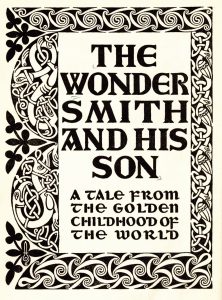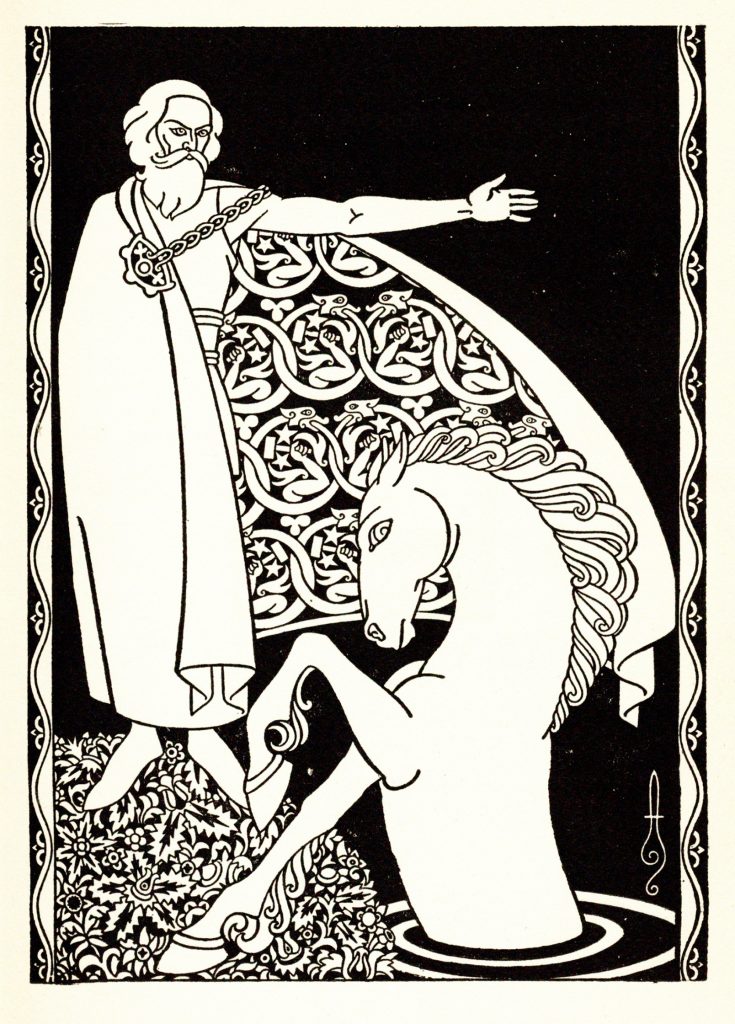The Printed Image: The Wonder Smith and His Son

For this installment of the The Printed Image I’ll be highlighting The Wonder Smith and His Son: A Tale from the Golden Childhood of the World, written by Ella Young and illustrated by Boris Artzybasheff. Published in 1927, the book received a Newbery Honor in 1928, and is part of the Joseph McGarrity collection in Distinctive Collections. The book also entered the public domain earlier this year.
In fourteen interconnected tales, Young recounts the mythic stories of the Gubbaun Saor, an archetypal builder figure within Celtic mythology similar to Greek mythology’s Daedalus, and the Gubbaun’s children; his natural born daughter Aunya and his adopted son Lugh (though he is simply referred to as ‘Son’ in the stories themselves). The stories are filled with strange word games and customs, and encounters with deities, elves, djinn, and other supernatural beings. Young was active within the Gaelic and Celtic revival movements in the 19th and 20th centuries, and so the book acts as a way to preserve these stories which were passed down through an oral tradition. As she she writes in the preface of the book,
People have forgotten about these things now, but in the thatched cottages in Gaelic-speaking Ireland and Scotland, they talk about him and his son Lugh and his daughter Aunya… They are glad when they find some one who does not know how Aunya tricked Balor’s messenger and how she got the better of the Gubbaun himself, because they want to have the pleasure of hearing a new person laugh at these stories.

“My blessing to you, Brother of mine;
White Love of Running Water.”
Page 35 from The Wonder Smith and His Son.
Boris Artzybasheff’s illustrations capture the timeless and fantastical nature of these stories. The black-and-white drawings are reminiscent of Aubrey Beardsley’s illustrations, which served as an early influence on Artzybasheff, and bring both an archetypal and surreal tone to the stories. Celtic influences can be detected in the clothing and foliage patterns, but these are also merged with Russian and Byzantine influences, with sharp angles in the figures and costumes, a flat perspective to the scenes, and in the design of the Gubbaun’s towers and “dunes.” This influence can be traced back to Artzybasheff’s birthplace in Kharkiv and to his studies in St. Petersburg, before he fled his homeland during the Russian civil war and emigrated to the United States.

“I am Hrut of the Many Shapes,
the Son of Sruth, the Son of Sru.”
Page 77 from The Wonder Smith and His Son.

“A dune with courts and passages and secret chambers.”
Page 103 from The Wonder Smith and His Son.

Detail from page 123 of The Wonder Smith and His Son.
Surreal elements are also a key visual trait in the creatures that the Gubbaun and his children encounter. Many of these seem to be a conglomeration of shapes and animal-parts that are constructed into their own unique beings. In one illustration, a goblin with the arms of a praying mantis stands next to a beast with tusks, horns, and three pairs of ears. In another, the neck of a horse-like creature morphs and merges into the snout of its own rider. These stylistic inventions help bring Young’s stories into a space out of time, that “golden childhood of the world,” while also serving as a precursor to Artzybasheff’s later work, when he would anthropomorphize technology, merging human and machine in the modern world.

“Our King bespeaks your help.
Behold the gifts and tokens of Balor!”
Page 65 from The Wonder Smith and His Son.
The Wonder Smith and His Son: A Tale from the Golden Childhood of the World is available in Falvey’s Digital Library, and can be viewed in the Rare Book Room during walk-in hours or by appointment. You can read more about Ella Young in the Digital Library, and see more of Boris Artzybasheff’s work in ArtStor and the Internet Archive.